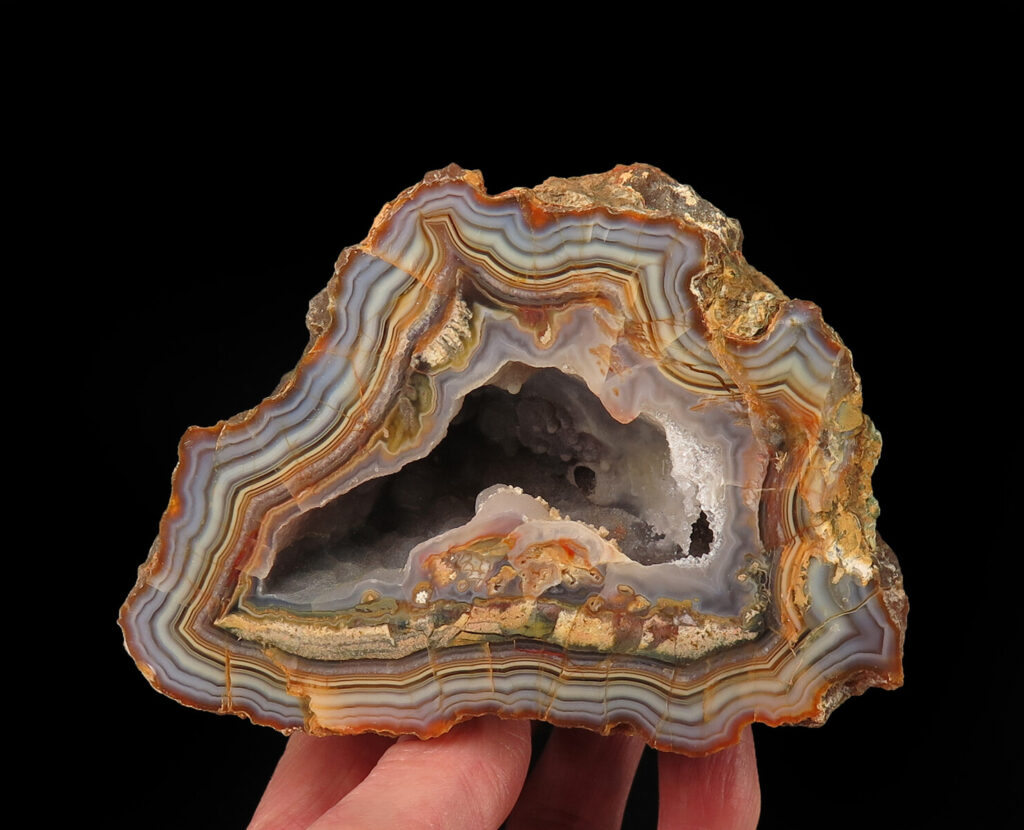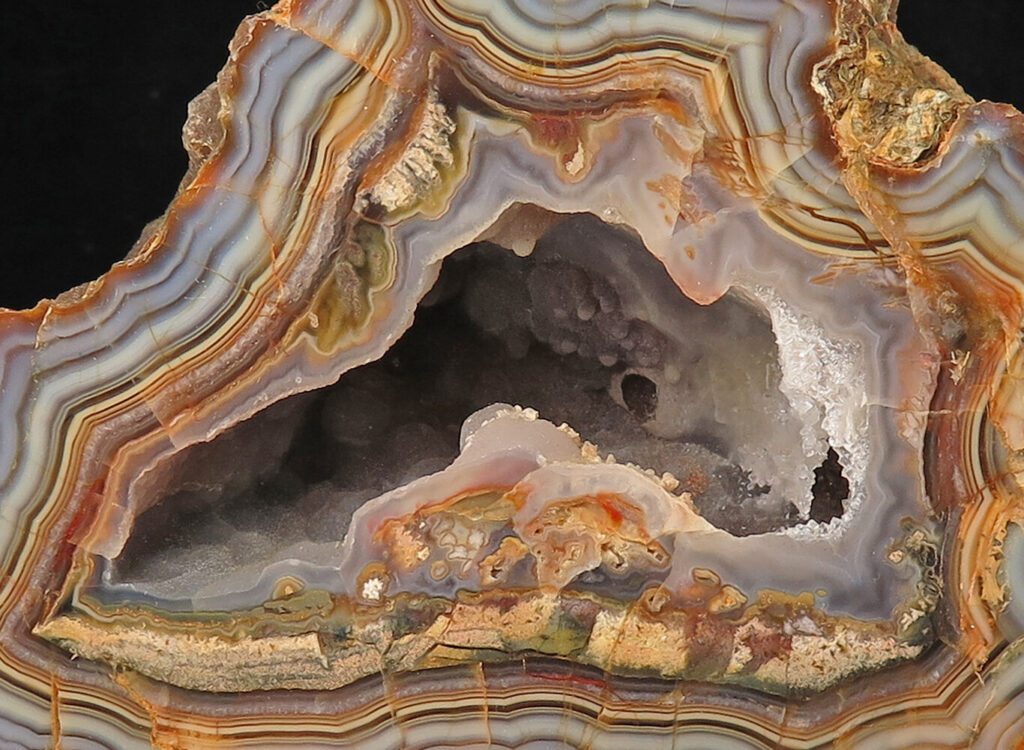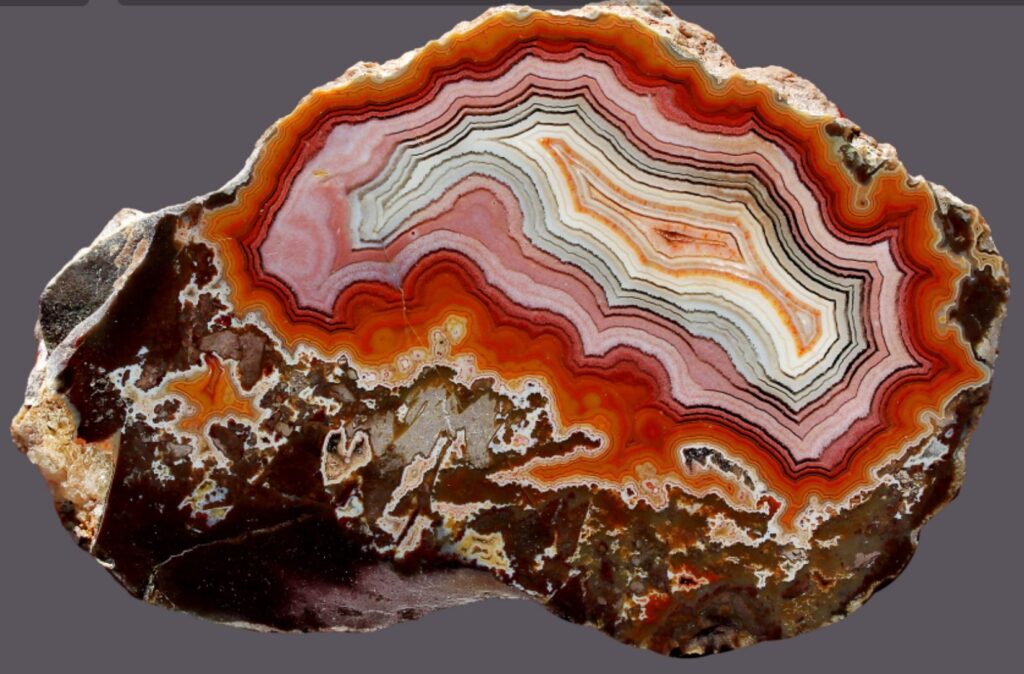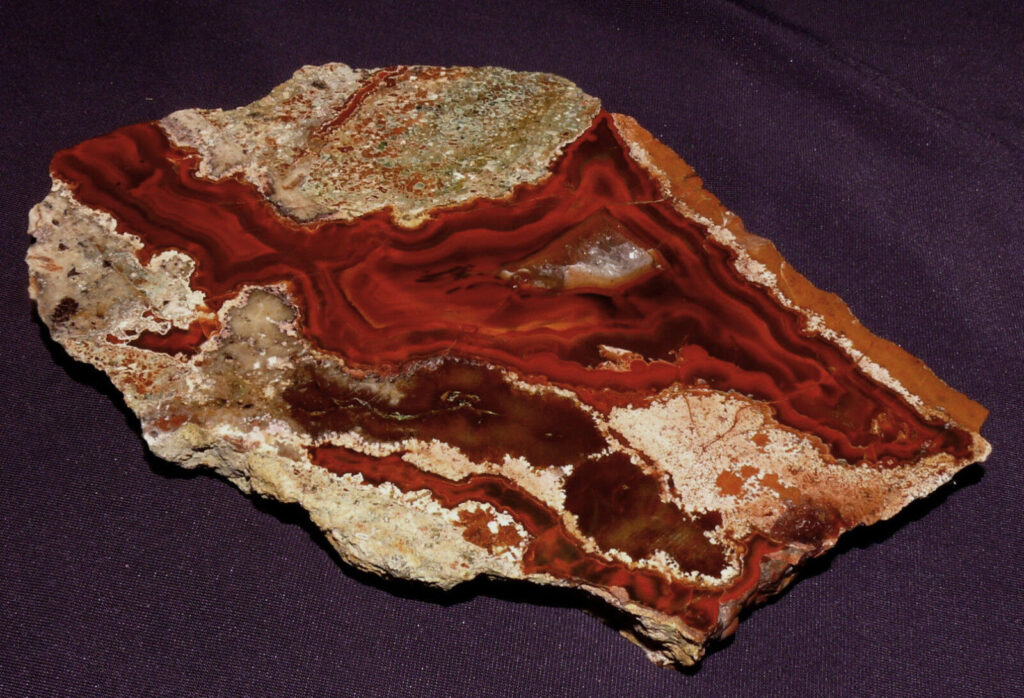Dryhead Agate is a fascinating type of chalcedony, a member of the quartz family, renowned for its vibrant and unique color patterns. These agates are particularly prized by collectors and artisans for their intricate banding and stunning array of colors, which often include combinations of red, orange, yellow, and cream. The vivid coloration is a result of various trace minerals within the quartz. Dryhead Agate is typically found in nodular formations, and when cut and polished, it reveals stunning patterns that are highly valued in jewelry and decorative arts.

Geological Formation
The formation of Dryhead Agate is an intriguing geological process tied to volcanic activity. These agates are typically formed in areas with a history of volcanic events, specifically in the vesicles or gas bubbles of igneous rocks such as basalt or rhyolite. Over millions of years, silica-rich groundwater percolates through these rocks. As the water evaporates and cools within these voids, it deposits layers of silica. The presence of different trace minerals in each layer results in the diverse and vibrant color patterns characteristic of Dryhead Agate.
This sequential layering solidifies into a hard, stable form, encapsulating a record of geological and chemical processes over time. The unique environmental conditions and mineral content specific to the Dryhead region contribute to the distinct appearance of these agates, making each piece a natural artifact of the geological history of its location.
Location and Geology of Dryhead Agate

Specific Location in the Dryhead Area of Montana
Dryhead Agate is specifically found in the Dryhead region of Montana, which is situated near the eastern part of the Bighorn Canyon National Recreation Area. This area is located on the Crow Indian Reservation, roughly between the towns of Billings and Lovell. The landscape is rugged and remote, characterized by the dramatic cliffs and steep valleys of the Bighorn Mountains. The access to Dryhead Agate sites is restricted and usually requires permits or special permissions due to its location on reservation land.
Geological Setting and History
The geological setting of the Dryhead region is deeply influenced by the Bighorn Basin, a large geologic basin rich in sedimentary rock formations that date back to the Paleozoic era. This area has a complex geological history, marked by episodes of volcanic activity, sediment deposition, and erosion processes that have shaped the landscape over millions of years. The presence of volcanic rocks like basalt and rhyolite in this area indicates past volcanic activity, which played a crucial role in the creation of conditions favorable for the formation of agates.
Types of Rock Formations Where Dryhead Agate is Found
Dryhead Agate is primarily found in igneous rock formations, particularly basalt and rhyolite. These rocks are key indicators of the region’s volcanic past:
- Basalt: This is a dark-colored, fine-grained igneous rock that forms from the rapid cooling of basaltic lava exposed at or very near the surface. The vesicles or cavities within basalt, formed by trapped gas during the cooling process, are typical sites where agates can form.
- Rhyolite: Similar to basalt, rhyolite is an igneous rock but is lighter in color and has a higher silica content. It also forms from volcanic lava and is known for its high viscosity at the surface. Rhyolite provides another common host rock for agate formations, where silica-rich solutions fill cavities to form agates.
Both of these rock types feature cavities and fractures that served as conduits for mineral-rich hydrothermal fluids. Over time, these fluids deposited layers of silica that eventually crystallized into the agates found today. Each layer in a Dryhead Agate can tell a story of the environmental conditions at the time of its formation, reflecting changes in temperature, pressure, and mineral composition over geological time scales.
Physical and Optical Properties of Dryhead Agate

Description of Colors and Patterns
Dryhead Agate is renowned for its rich and varied color palette, which includes shades of red, orange, yellow, white, and sometimes even green and blue. These colors are often vivid and can appear in layers, bands, or swirls that create eye-catching patterns. The diversity in coloration is due to the presence of various trace elements during the agate’s formation, such as iron, manganese, or chromium, which contribute to the different hues. Patterns can range from solid, uniform colors to intricate bands, which can be wavy, circular, or form concentric layers, often resembling the rings of a tree trunk.
Physical Properties like Hardness and Durability
Dryhead Agate, like other agates, is a variety of chalcedony and thus has a hardness of about 6.5 to 7 on the Mohs scale, making it relatively hard and resistant to scratches. This hardness contributes to its durability, making it suitable for use in jewelry and other decorative items that may be subject to daily wear. The stone’s robust nature also allows it to be cut, polished, and shaped without losing its aesthetic appeal, making it a favored material among lapidary enthusiasts.

Optical Characteristics such as Translucency and Refraction
One of the most striking optical properties of Dryhead Agate is its translucency. This quality varies from piece to piece; some agates may be nearly opaque, while others allow light to pass through thinly sliced sections. This translucency can enhance the depth and richness of the colors, adding to the stone’s visual appeal.
The refraction of light in Dryhead Agate also plays a crucial role in its appearance. Being a form of silica, it has a refractive index typically between 1.530 and 1.540, which influences how light bends as it passes through the stone. This can accentuate the layered patterns within the agate, causing them to glow or appear three-dimensional under direct light. Moreover, the polished surface of agate can give it a glossy finish that further enhances its aesthetic quality, making the colors seem more vibrant and the patterns more pronounced.
Together, these physical and optical properties make Dryhead Agate a highly valued gemstone in both collector and consumer markets, cherished for its natural beauty and the skill required to reveal it through cutting and polishing.
Uses of Dryhead Agate

Dryhead Agate, with its striking visual appeal and durable properties, finds a variety of uses in both artistic and practical applications. Here are some of the primary ways this beautiful stone is utilized:
1. Jewelry Making
- Rings, Pendants, and Earrings: The hardness and durability of Dryhead Agate make it an ideal choice for everyday jewelry pieces like rings, pendants, and earrings. The rich colors and unique patterns of each stone allow for distinctive, one-of-a-kind designs that are highly prized in the market.
- Beads and Bracelets: Agate can be cut into beads of various shapes and sizes, which are then used to create bracelets and necklaces. These pieces often showcase the natural banding of the agate, appealing to those who prefer organic, earthy styles.
2. Decorative Items
- Sculptures and Carvings: Artists and craftsmen may use Dryhead Agate for small sculptures or intricate carvings, taking advantage of the stone’s ability to be finely detailed and polished to a high gloss.
- Desk and Home Decor: Agate slices, particularly those that are translucent and colorfully banded, are frequently used as decorative pieces. They can be displayed as standalone art pieces or incorporated into functional items like tabletops, coasters, and lamp bases.
3. Healing and Spiritual Uses
- Crystal Healing: Like many varieties of agate, Dryhead Agate is sometimes used in crystal healing practices. It is believed to promote balance and protection, as well as enhance physical strength and stamina.
- Meditative Tool: The soothing patterns and colors of Dryhead Agate are said to aid in relaxation and meditation, helping to harmonize the mind and body.
4. Collecting
- Specimen Pieces: Due to its unique and visually appealing characteristics, Dryhead Agate is a popular choice among mineral collectors. Enthusiasts often seek out the most vibrantly colored and intricately patterned specimens to add to their collections.
5. Technological Applications
- While not as common, the hardness and stability of agate have historically made it useful in certain industrial and technological applications, such as in precision instruments where components must be wear-resistant and durable.
Overall, the versatility of Dryhead Agate in terms of both aesthetics and physical properties lends it to a wide range of uses, from personal adornment to home décor and beyond. Each piece of Dryhead Agate holds a natural allure that can elevate and personalize the items in which it is used.




































